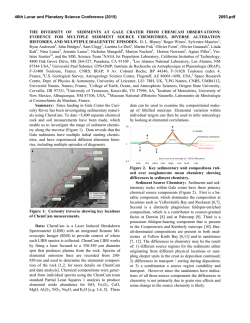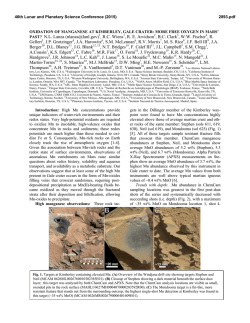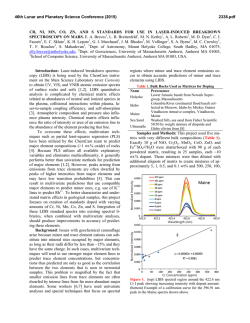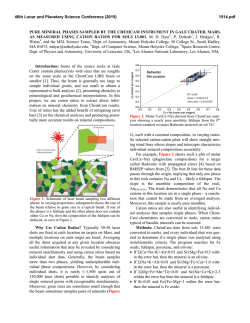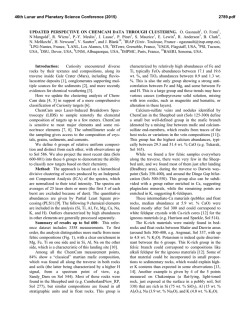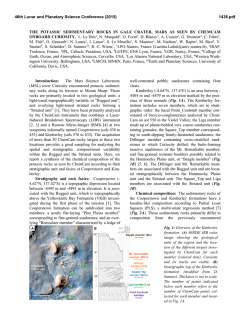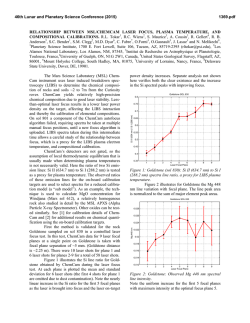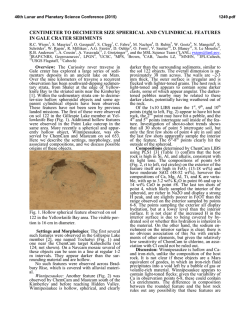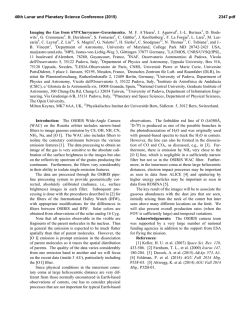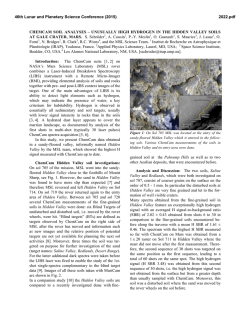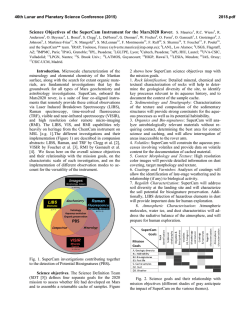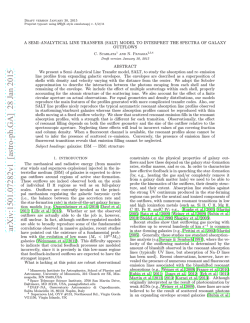
2850 - USRA
46th Lunar and Planetary Science Conference (2015) 2850.pdf DETECTION OF PHOSPHOROUS BY CHEMCAM IN GALE CRATER. J. G. Blank1, 2, A. M. Ollila3, N. L. Lanza4, O. Forni5, N. Mangold6, M. Nachon6, S. M. Clegg4, A. Yen7, S. Maurice5, R. C. Wiens4, 1NASA Ames Research Center, Moffett Field CA USA, 2Blue Marble Space Institute of Science, Seattle WA USA, 3Chevron Energy Technology Company, Houston TX USA,4Los Alamos National Laboratory, Los Alamos, NM USA, 5Univ. Toulouse & CNRS, IRAP, Toulouse, France, 6Univ. Nantes & CNRS, Nantes, France, 7JPL Pasadena CA USA Introduction: Phosphorous has an extensive chemistry, due to its tendency to form covalent organophosphorus compounds and its critical role in the biochemistry of life. On Earth, P ranks 11th in abundance in crustal rocks, at ~1120 ppm average [1]. Terrestrial Pbearing minerals are usually orthophosphates, of which the dominant phase is apatite (Ca5(PO4)3(F, Cl, OH)2). In contrast, the most abundant phosphate in martian meteorites is the anhydrous phase merrillite (Ca9NaMg(PO4)7) [2]. Phosporous (P) has been detected on the surface of Mars using APXS instruments on the MER and Curiosity rovers, providing evidence to support both primary volcanic and secondary weathering processes (e.g., [3]; [4]. More recently, P has been identified in LIBS spectra collected by ChemCam on both soil and rock targets [5]. Observations from APXS instruments on three missions have revealed a range of P contents in Mars surface materials, from 0.61-0.89 wt% (as P2O5) in soil and fine grained rock in Gale Crater ([6]; [7]) to 5.110.2 wt% (as P2O5), high-phosphorus “Wishstone Class” alkaline volcanic rocks in Gusev Crater [4]. Recent laboratory work on the dissolution rates of phosphate minerals under simulated martian condi tions [8] led those authors to infer much greater water/rock ratios than predicted for analagous terrestrial environments and a corresponding higher availability of P for abiogenic reactions, making the determination of this element’s abundance and distribution on Mars even more intriguing. Here, we consider potential P emission lines and estimate a corresponding ChemCam detection limit for P based on analysis of well-characterized terrestrial standards. Element Quantification with ChemCam: ChemCam provides elemental identification and quantification using laser-induced breakdown spectroscopy (LIBS), an emission spectroscopy technique in which a pulsed laser is focused on a target up to several meters distant from the rover ([9];[10]). A portion of the target material is converted to a plasma, exciting each species to a higher state; as the species relax, they emit light at characteristic wavelengths. Instrument hardware (i.e., the laser and spectrometers) and operational parameters (i.e., stand-off distance, energy density, and observational window of the plasma) constrain the obtainable accuracy and precision of a measurement. Major element contents are quantified by LIBS using partial least-squares regression and principal component analysis (e.g., [11]). Trace element contents can be quantified using univariate analysis [12], and this requires a calibration curve that depends on appropriate standards. Determining optimal P Emission lines: In order to determine the best P emission lines in ChemCam data, the emission lines in terrestrial laboratory standards were examined and compared to those of martian targets. Primary elemental emission lines for P from the NIST database (www.nist.gov) are listed in Table 1, in order of increasing wavelength. P emission lines in the UV range of ChemCam (240-342 nm) have been observed in a few Gale Crater targets (data analyzed through sol 707), including sol 72 Epworth_5 (a soil) and sol 368 Blackhead_7 (a fine-grained rock), as noted in the right column of the Table. In general, P is a comparatively poor emitter at the ChemCam laser energy and thus its detection using LIBS is challenging [13]. Based on our analysis of P peak intensities and overlapping emissions, the P I line (255.4 nm), shown in bold with the second-highest emission intensity, lacks interference from other element lines and is likeTable 1. Anticipated P Emission Lines with ChemCam LIBS Line Wavelength Peak (nm)* Interferences Emission Lines seen in Two Gale Crater Targets PI 253.637 Multiple Fe lines Epworth_5 (shoulder on Fe) PI 255.403 Epworth_5, Blackhead_7 PI 255.568 P, Fe Epworth 5 * For sample emission in vaccuum (source: NIST) ly to give the most accurate estimate of P content in ChemCam data. A preliminary sample suite of laboratory standards with known compositions was used to explore the sensitivity of ChemCam to P content (Fig. 1). Materials include two powdered phosphate rocks, SARM32 and USZ14-94, with 39.96 and 26.38 wt% P2O5, respectively, spanning a large range in abundance. Lower P samples analyzed were BHVO2 (USGS basalt), JDO1 (dolomite), GYPA (gypsum), and the Norite ChemCam calibration standard [14], containing 0.27, 0.034, 0.011, and 0.0078 wt% P2O5, respectively. No P emi 46th Lunar and Planetary Science Conference (2015) 2850.pdf Fig.1. Compilation diagram of normalized LIBS spectra of six standards from the Chem-Cam materials library, three terrestrial apatite minerals (whole rock, not powdered), and two ChemCam sample targets in Gale Crater. Terrestrial samples were analyzed with the ChemCam engineering model in a Mars Chamber (~7 Torr CO2) at a stand-off distance of 1.5 m and a laser power of ~14 mJ/pulse (cf., [12]; [15]. Martian samples Epworth_5 (soil) and Blackhead_7 (fine-grained rock) were analyzed at distances 2.27 m and 3.36 m from Curiosity, respetively. Three P I lines are visible, labeled at 253.64, 255.42, and 255.57 nm; 255.42 nm has little or no interference from other element emission lines and is likely will provide the most accurate estimates of P contents. sion lines were detected in these low-P samples. In contrast, the three apatite samples showed clear P lines (Fig. 1). All samples were prepared as pressed powdered pellets except for the three apatite standards. Fig. 1 also illustrates a variety of P emission bands and interference from Fe emissions. Quantifying P in ChemCam data: At this time, a detailed calibration of P with ChemCam has not been completed. However, assuming a linear relation between peak intensity and concentration, we predict that samples Epworth_5 and Blackhead_7 contain ~17 and ~5 wt% P2O5, based on the peak intensities of their P I emission lines at 255.4 nm ratioed to that of USZ1494. Upon consideration of the spectra for the group of samples, we predict that the detection limit for P with ChemCam is ~2-3 wt% P2O5. This value may be refined further through calibration using an expanded laboratory training set. References: [1] Greenwood & Earnshaw (2002) Chemistry of the Elements, 2nd Ed.; [2] Jolliff et al. (2006) Am. Mineral. 91:1583; [3] Yen et al. (2014) Eos P34A-04; [4] Usui et al. (2008) J.Geophys. Res. 113: E12S44; [5] Forni et al. (2014) Intl. Conf. Mars 8:1062; [6] Schmidt et al. (2014) JGR Planets 119:1; [7] Gellert et al. (2014) LPSC 1876; [8] Adcock et al. (2013) Am. Mineral. 99:1121; [9] Maurice et al. (2012) Space Sci. Rev. 170:95; [10] Wiens et al. (2012) Space Sci Rev. 170:167; [11] Clegg et al. (2009) Spectrochim. Acta B 64:79; [12] Ollila et al. (2014) J.Geophys. Res. Planets 119:255; [13] Cremers & Radziemski (2013) Handbook of Laser-Induced Breakdown Spectroscopy, 2nd Ed.; [14] Fabre et al. (2011) Spectrochim. Acta B 66:280; [15] Wiens et al. (2013) Spectrochim. Acta B 82:1.
© Copyright 2026
